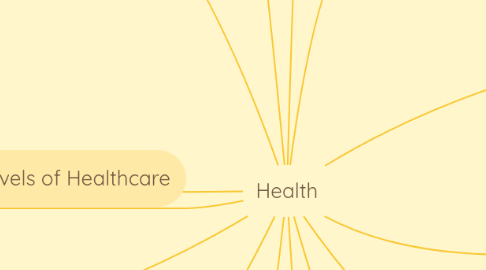
1. 3 Historical Approaches To Healthcare
1.1. Medica;/Biomedical/"Curative
1.2. Behavioural/Lifestyle
1.3. Socio-Environmental
2. Determinants of Health
2.1. Biology and Genetic Endowment
2.2. Health Services & Social support networks
2.3. Personal Health practice & Coping skills
2.4. Income & Social status
2.5. Education & Literacy
2.6. Employment & Working Conditions
2.7. Healthy Child Development
2.8. Social Environments
2.9. Physical Environments
2.10. Gender & Culture
3. Indigenous Health
3.1. Pre Contact
3.1.1. Self Sustaining
3.1.1.1. Traditional Medicines and food
3.1.1.1.1. Hunting & botanicals
3.1.1.2. Traditional social system
3.1.1.2.1. Political Governance
3.1.1.2.2. Trade-traditional forms of economy
3.1.1.2.3. Traditional laws of land
3.1.1.3. Family
3.1.1.3.1. Kinship, place in the world
3.1.1.3.2. Elder respect
3.2. Major Difficulties
3.2.1. Globally, many governments do not recognize the poor health among indigenous communities
3.2.2. Poor standard of health due direct result of colonization. Affected:
3.2.2.1. Physical
3.2.2.2. Mental
3.2.2.3. Emotional
3.2.2.4. Spiritual
3.2.3. Illnesses associated with overcrowding and environmental contamination.
3.2.3.1. Rapid upsurge of lifestyle diseases
3.2.3.1.1. Respiratory illnesses associated with cigarette smoking
3.2.3.1.2. Disease & social issues associated with alcohol misuse and abuse.
3.2.3.1.3. Emotional, Mental, & psychiatric illnesses
3.2.3.1.4. Interpersonal & family violence
3.2.3.1.5. Sexually transmissible diseases
4. 5 Levels of Healthcare
4.1. Health Promotion
4.2. Disease & Injury Prevention
4.3. Rehabilitation
4.4. Supportive Care
4.5. Diagnosis & Treatment
5. Context
5.1. External
5.1.1. Environmental
5.1.2. Economic
5.1.3. Political
5.1.4. Ecological
5.2. Internal
6. Epidemiology and Disease Prevention and
6.1. Epidemiology
6.1.1. The study of distribution and determinants of health, disease, or injury in human populations. & the application of this study to the control of health problems & positive health status
6.2. Morality
6.2.1. # of deaths in a specified population
6.3. Morbidity
6.3.1. # of illnesses within specified population
6.4. Incidence
6.4.1. number of new cases within specified time period
6.5. Prevalence
6.5.1. total # of cases within specified time period
6.6. Epidemic
6.6.1. the occurrence of more cases of a disease than expected
6.7. Endemic
6.7.1. rate of its occurrence is typical to population
6.8. Pandemic
6.8.1. Disease that occurs over a wide geographic area and affects a very high proportion of the population.
6.9. Surveillance
6.9.1. close watch over a person, group, or area; supervision
7. Culture
7.1. Cultural Safety
7.1.1. the practice of analyzing power imbalances in order to provide quality nursing care for individuals from different ethnicities
7.2. Cultural Sensitivity
7.2.1. being aware that cultural differences exist and have an effect on values, learning, and behavior.
7.3. Cultural Competence
7.3.1. Practices, behaviours, and policies that allow nurses to provide culturally appropriate care
8. My Personal Idea of Health
8.1. Body
8.1.1. Exercise
8.1.1.1. Yoga
8.1.1.2. Spin Class
8.1.1.3. Hikes
8.1.1.4. Walks
8.1.1.5. Swimming
8.1.2. Food
8.1.2.1. Healthy Eating
8.1.2.2. Eating Regularily
8.1.2.3. Avoiding excessive junk
8.1.3. Managing my Condition
8.1.3.1. Taking Medication on time
8.1.3.2. Being mindful of triggers
8.1.3.2.1. Trying Gluten Free
8.1.3.3. Regular doctors visits
8.1.3.3.1. Blood tests
8.1.3.3.2. Regular exams and checkups
8.1.3.4. Being open about when I'm struggling
8.2. Mind
8.2.1. Mental Health
8.2.1.1. Speaking out when i'm struggling
8.2.1.1.1. Therapy
8.2.1.1.2. Speaking with loved ones
8.2.1.2. Being mindful of stresses
8.2.1.2.1. understanding how to minimize stressors
8.2.1.2.2. Better time management skills
8.3. Spirit
8.3.1. Religion & Spirituality
8.3.1.1. Being open to spiritual experiences
8.3.1.2. Listening to the experiences of others
8.3.1.3. Open mindedness to variety of spiritual groups & various religions
9. Principles of Primary Care
9.1. Access
9.2. Participation
9.3. Health Promotion
9.4. Appropriate Skills
9.5. Technology
9.6. Intersectoral/Interdisciplinary Collaboration
10. Levels of Health Care
10.1. Promotive
10.2. Preventitive
10.2.1. Primary
10.2.2. Secondary
10.2.3. Tertiary
10.3. Curative
10.3.1. Primary
10.3.2. Secondary
10.3.3. Tertiary
10.4. Rehabilitive
10.5. Supportive
11. Health
11.1. Health Promotiom
11.1.1. the process of enabling people to increase control over, and to improve, their health
11.2. Population Health Promotion
11.2.1. An approach aimed at improving the health of entire populations/groups. Recognizes the interrelated factors influencing the health of populations
12. Attitudes, Values, and behaviours that reflect health promoting nursing practice
12.1. Holistic Perspective
12.2. Expert Knowledge of client
12.3. Client autonomy and choice
12.4. Genuine participation and involvement
12.5. Mutuality
12.6. Diversity positively valued
12.7. Advocacy
12.8. Equity and Social Justice
13. Risk
13.1. The chance of loss from an event that cannot be entirely controlled
13.2. Risk Factors
13.2.1. Variables that increase the vulnerability of an individual or a group to an illness or accident
13.3. Population at risk
13.3.1. those in the population who are susceptible to a particular disease or condition
14. Health Promotion Work
14.1. Empowerment
14.1.1. Giving individuals the ability to take control over their own health
14.1.2. Providing Resources: Programs, professionals, etc. To individuals in need of services
14.1.3. Providing the feelings of being empowered by good health practices
